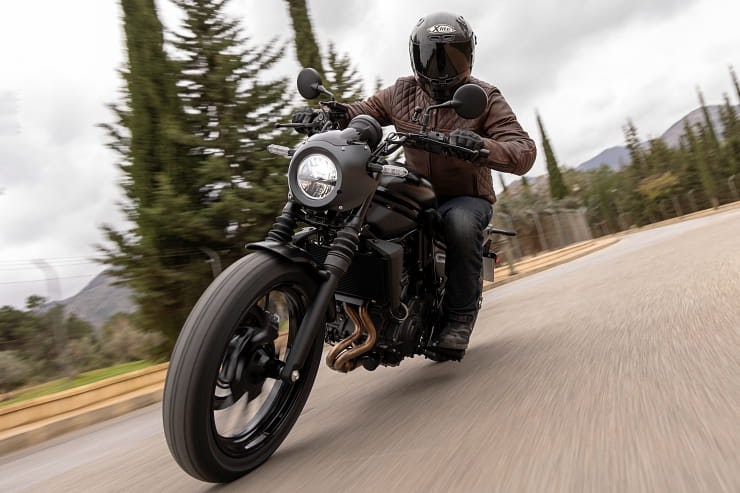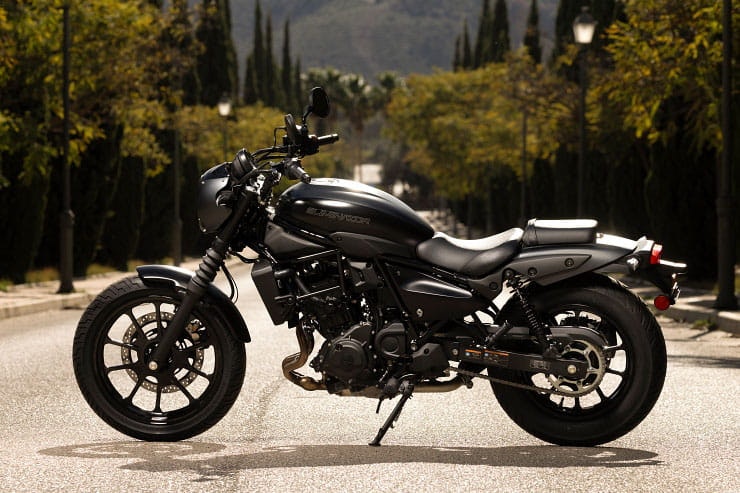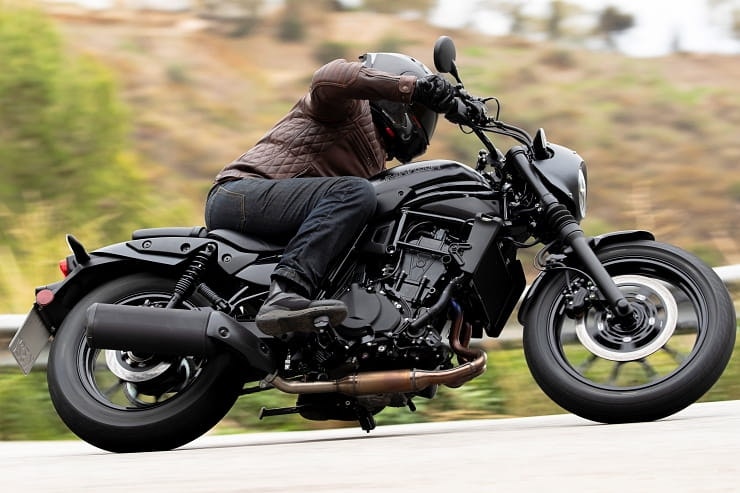Kawasaki Eliminator 500 (2024) – Review
Technical Review - Ben Purvis - June 2023
Launch Review - Martin Fitz-Gibbons - February 2024
Price: £6134 / £6534 (SE) | Power: 44.8bhp | Weight: 176kg / 177kg (SE) | Overall BikeSocial Rating: 3/5
Way back in 1985, Kawasaki’s original Eliminator was a mad concoction of drag-racer aggression, cruiser styling and, thanks to a GPZ900R-based engine, sportsbike heart. The result was described in breathless US sales brochures as “Quicker than a cobra… can hit 50mph in a mind-bending 2.16 seconds… quicker than anything else on the streets.” Phwoar, blimey, cowabunga dude, etc.
In 2024, after a long absence from Kawasaki’s UK lineup, the Eliminator name is back. The long, low silhouette remains, as does the composite of cruiser aesthetic with sportsbike engine. Only this time the motor has been taken from Kawasaki’s Ninja 500. So rather than being crammed full of tarmac-tearing testosterone and feral firepower, the new Eliminator is designed to be a friendly, accessible, easy-to-ride A2-compliant companion, complete with confidence-boosting rock-bottom seat height.
Extremely accessible 735mm seat height, with an option to drop it even further
Smooth engine, well-mannered throttle and light clutch make it super easy to ride
Lighter than Honda’s Rebel 500 and Royal Enfield’s Meteor 350
Quiet exhaust and 180° crank aren’t overflowing with character
Up close engine detailing could be better, with exposed cables and hoses
Slightly cramped ergonomics for an average-height or tall rider
2024 Kawasaki Eliminator 500 price
The Eliminator 500 is available in two versions. The standard model is advertised at £5999, but as Kawasaki don’t include on-the-road costs you’ll need to add £135 (£6134) to ride it away from the showroom. There’s also an SE version (tested here), expected to account for around 80% of UK sales, which costs £400 more (£6534 otr).
The SE uses the same engine and chassis as the base model, the differences coming down to: a headlight cowl; rubber fork gaiters; and a USB-C charging socket on the right handlebar. There’s also a handful of subtle cosmetic changes, such as a different seat pattern, different paint colour (dark grey on the SE instead of black on the standard bike…) and a darker exhaust heat shield. That’s your lot.
The Eliminator has been purposefully priced just below Honda’s CMX500 Rebel, a bike that’s also available in a base version (£6399) and a Special Edition (£6799) which features a headlight cowl and different colours. Compare like for like and the Eliminator is £265 cheaper.
If you’re considering a PCP scheme through Kawasaki K-Options Finance, then a £1364 deposit leaves 36 monthly-payments of £85 for an SE. For a base model, there’s a slightly smaller deposit and monthlies drop to £79. With only six quid a month between the two, you can see why Kawasaki UK expect SE sales to overshadow the standard Eliminator.
2024 Kawasaki Eliminator 500 Engine & Performance
The Eliminator shares its 451cc parallel twin with Kawasaki’s equally new Ninja 500 and Z500. The engine is in an identical state of tune, with the exact same performance figures as its sportier siblings: peak power is 44.8bhp at 9000rpm, with 31.4lb·ft of torque at 6000rpm.
The motor comes from an evolution of the Ninja 400 twin, with capacity increased by lengthening piston stroke (from 51.8mm to 58.6mm). The result is a meatier-feeling motor, with more grunt at lower revs. There’s no additional peak power, but given the 400 was already close to the 47bhp limit for A2 licence holders, that wasn’t really on the cards anyway.
Otherwise, it’s all classic Japanese twin territory: four valve heads; double overhead cams; 180° crank; water-cooling. There’s a simple cable-operated throttle (no ride-by-wire, nor any computer-controlled secondary butterflies), yet the response is sublimely smooth, with not a hint of hiccup. And it’s not just the throttle that’s smooth: there’s virtually no vibration either. The 180° crank means primary imbalance is naturally low, though the motor does feature a balance shaft (presumably to deal with secondary tingles). Handlebars are rubber-mounted, as is the seat, while footpegs are both rubber-topped and heavily weighted, all adding further layers of insulation between engine and rider.
So, while it may be a motor from a sportsbike, it doesn’t feel aggressive or demanding. Yes, it retains the ability to rev up to an indicated 11,000rpm, which is distinctively un-cruisery, but the Eliminator’s ergonomics and chassis also make it clear that’s not how it really wants to be ridden. Instead, it’s happiest thrumming along from as low as 2500rpm, pulling keenly and cleanly through its bottom end and midrange up to around 7000rpm, then snicking slickly up through the six well-spaced gears using the astonishingly light-action slip/assist clutch.
There’s no snarl, no anger, no wild side – this is a refined, relaxed motor that feels polite, eager to please and happy to help. It’s big on confidence and ease-of-use, but the muted exhaust note, minimal vibration and droney nature of a 180° crank mean it’s also a motor that lacks distinctive character. It’s a bit generic, a bit ready salted, a bit tap water. It definitely doesn’t chug and thump along full of presence and drama the way you might expect a cruiser to.
2024 Kawasaki Eliminator 500 Handling & Suspension (inc. Weight & Brakes)
The Eliminator’s long, low proportions are underpinned by its long, low tubular steel trellis frame. This accounts both for its whopping wheelbase of 1520mm (5ft), plus its petite seat height of just 735mm (29in). Up front sits a pair of unadjustable, right-way-up 41mm telescopic forks, kicked out at a decidedly jaunty angle – rake is a surprisingly extreme 30°. At the rear is a pair of simple twin shocks, adjustable for preload via stepped 5-position collars. Wheels are 18in front and 16in rear, wearing chunky 130 and 150-section tyres made by IRC.
At walking speed the steering can feel a touch heavy, an inescapable consequence of that large front wheel, kicked-out geometry and fat front tyre. Threading through early morning traffic and mini-roundabouts the Eliminator isn’t quite as nimble, as agile or as precise as a regular roadster, but it’s still impressively light and very manageable by cruiser standards. Kerb weight is 176kg for the standard bike, with the SE carrying an extra kilo. Either way, it’s considerably lighter than Honda’s CMX500 Rebel, which weighs a claimed 191kg. Even more remarkable is that the Eliminator is the same amount lighter than Royal Enfield’s Meteor 350 (also 191kg).
Once out of town and up to countryside speeds, the Eliminator swings easily from side to side and makes a decent fist of slicing along tight, twisty mountain roads – at least until the footpegs scrape. It’s stable, goes where you intend, holds a line without protesting and never tries to argue with you or your steering inputs. Front-end feel and feedback perhaps isn’t delivered with the clearest communication, especially with that front tyre being so far from the rider, but it’s plenty good enough for its intended use. Ride quality is decent rather than spectacular – with only 90mm of rear wheel travel from the twin shocks, you don’t want to clatter over speed bumps too heavily.
The braking setup is simple: a single disc at each end (310mm front; 240mm rear), each with a sliding two-piston caliper. There’s a Nissin ABS system, and as you’d probably expect it’s not lean-sensitive and can’t be switched off. The front lever isn’t span adjustable, but the brake bites gently and progressively, and the rear brake gives good feel at low speed.
2024 Kawasaki Eliminator 500 Comfort & Economy
Back when the original Eliminator was built for hot-rod quarter-mile bragging rights, a low centre of gravity was essential to mitigate wheelies and help it drive off the line as fast as possible. Today the 500 features the same proportions but for a very different reason: confidence, rather than performance.
The Eliminator’s low 735mm (29in) seat should allow most riders to easily get both feet flat on the ground. But for those particularly short in stature, a lower seat option drops saddle height a further 20mm, down to just 715mm (28in).
Otherwise, the riding position is actually more like a regular naked roadster than a classic cruiser. There’s no feet-forward stance, no high-and-wide handlebar holding hands up in unusual places. Mid-mount pegs and a fairly narrow, flat bar mean the Eliminator’s ergonomic triangle isn’t massively removed from that of a Z400.
At 5ft 9in I found the legroom a smidge cramped for my frame – not uncomfortable, just a little tight. The good news for folk feeling the same way is that there’s also a taller seat option, which raises seat height by 30mm to 765mm (30in) and creates a shade more room to shuffle about.
With no wind protection the Eliminator isn’t intended as a bike for churning out endless high-speed motorway days, but given the reasonably natural stance and lack of engine vibration at speed it could do longer distances reasonably easily, if at a steady pace. The fuel tank holds just 13 litres, but the claimed 74.3mpg economy would put maximum theoretical range north of 200 miles. We didn’t have a chance to measure real-world fuel consumption during the launch.
2024 Kawasaki Eliminator 500 Equipment
A small, circular, black-on-white LCD dash sits slightly offset on the top yoke. In the centre is a clear, easy-to-read digital speedo. Above it runs a scrolling rev counter and a clock; below is trip information and a six-bar fuel gauge. There’s also a gear position indicator tucked away off to the right side of the display. All in all it’s an ideal balance of form and function – a good amount of information presented cleanly, neither fussy nor overwhelming, and all completely logical and understood roughly 1.2 seconds after you turn the ignition key.
Like an increasing number of other Kawasakis, the Eliminator comes with the ability to connect via Bluetooth to their ‘Rideology’ app. This allows you to check some vehicle information, view riding logs and tweak simple settings, but it’s not what we’d call full phone connectivity – unlike other manufacturer’s apps you can’t, for example, use it to answer calls or control music while riding, nor does it offer turn-by-turn navigation.
Speaking of gadgets, the SE model comes with a USB-C charging socket – but it’s not exactly subtle. Instead it’s a large unit with a big waterproof rubber flap, mounted rather indiscreetly on a bracket on the right handlebar, near the brake reservoir. It’s hardly the nicest thing to have in your eyesight when you look down at the cockpit. It could surely have been integrated more neatly – which in turn makes you wonder why Kawasaki didn’t bother.
Lighting is LED all round, from the 130mm-diameter round headlight, to the clear-lens indicators, to a tail-light that’s designed to look like the part from the original 1985 Eliminator. But that’s about where the modern touches end – there’s no traction control, no riding modes, no quickshifters or IMUs or snazzy mod-cons. The Eliminator prefers to keep things simple.
2024 Kawasaki Eliminator 500 Rivals
Honda CMX500 Rebel | Price: £6399
The best-selling ‘custom’ bike across Europe in 2021 and 2022 (according to Honda) and the most obvious competitor for the Eliminator. Virtually identical on top-end power, the Honda might offer a fraction more low-down grunt but it also weighs 15kg more. Otherwise, not a lot to split them on paper.
Power/Torque: 45.6bhp/31.9lb-ft | Weight: 191kg
Royal Enfield Meteor 350 | Price: £4219
A sales phenomenon, the Meteor 350 is largely responsible for a 50% growth in the medium-size cruiser market across Europe in the past two years. But dynamically it’s a long way short of the Eliminator, with an air-cooled 20bhp single, basic chassis and deceptively hefty kerb weight. Cheap though, and charming in its own way.
Power/Torque: 20bhp/20lb-ft | Weight: 191kg
Royal Enfield Shotgun 650 | Price: £6699
Another Enfield, but arguably a closer match than the Meteor 350 when it comes to power, performance and price. Costing just £165 more than an Eliminator SE, Royal Enfield’s new Shotgun 650 also offers a similar recipe blending custom/cruiser cool, mid-set footpegs, and mid-40s horsepower. Heavier and taller, however.
Power/Torque: 46.4bhp/38.6lb-ft | Weight: 241kg
2024 Kawasaki Eliminator 500 Verdict
The Eliminator 500 offers a welcoming, accessible, confidence-inspiring introduction to mid-capacity motorcycling. Almost every single physical element feels like Kawasaki’s designers sat down and began a conversation by asking, “How can we make this as easy for the rider as possible?” The clutch lever is so light you half-wonder whether they’ve forgotten to attach the cable. The throttle response is faultlessly soft and smooth. The engine offers linear, predictable power, entirely devoid of any daunting drama. The gearbox needs nothing more than a light touch and shifts with confident, positive clicks. The switchgear is obvious and intuitive, the dash doesn’t require a masters degree to operate. The low seat combined with a sub-180kg kerb weight ensures riders of all sizes will find it supremely manageable to push or paddle around.
But while the Eliminator does everything extremely easily, the downside is that it doesn’t do anything with much flair. It lacks a bit of sparkle, flamboyance, some distinctive charm or charisma. It’s so smooth, so refined, so inoffensive that it’s almost viceless. A richer exhaust note, or a more evocative engine character (cough, 270-degree crank, cough…) would definitely not go amiss. Nor would a bit of a tidy-up around the engine, where various coolant hoses, wires, cables and brackets seem to be scattered around undisguised. It gives the impression this was an engine that was never really meant to be on display.
Enough nit-picking. Up-close details and subjective notions of character aside, the big picture is that the Kawasaki Eliminator 500 delivers on what it promises to be: one of the most accessible, confidence-inspiring, A2-class cruisers you can buy.
If you’d like to chat about this article or anything else biking related, join us and thousands of other riders at the Bennetts BikeSocial Facebook page.
2024 Kawasaki Eliminator 500 Technical Specification
Looking for motorcycle insurance? Get a quote for this motorbike with Bennetts bike insurance
What is MCIA Secured?
MCIA Secured gives bike buyers the chance to see just how much work a manufacturer has put into making their new investment as resistant to theft as possible.
As we all know, the more security you use, the less chance there is of your bike being stolen. In fact, based on research by Bennetts, using a disc lock makes your machine three times less likely to be stolen, while heavy duty kit can make it less likely to be stolen than a car. For reviews of the best security products, click here.
MCIA Secured gives motorcycles a rating out of five stars (three stars for bikes of 125cc or less), based on the following being fitted to a new bike as standard:
A steering lock that meets the UNECE 62 standard
An ignition immobiliser system
A vehicle marking system
An alarm system
A vehicle tracking system with subscription
The higher the star rating, the better the security, so always ask your dealer what rating your bike has and compare it to other machines on your shortlist.


